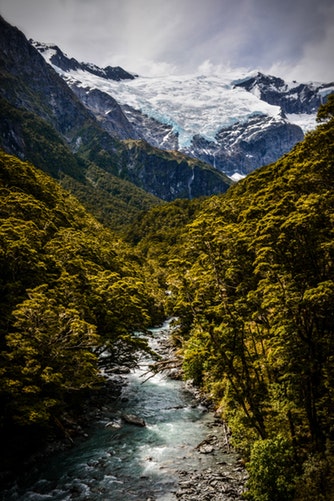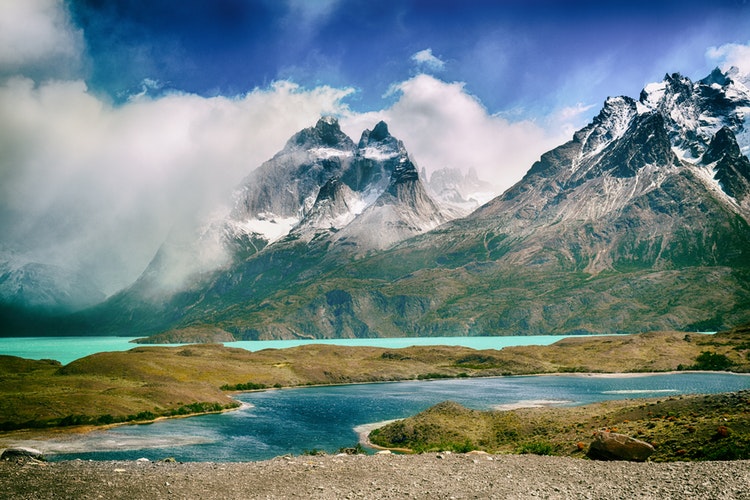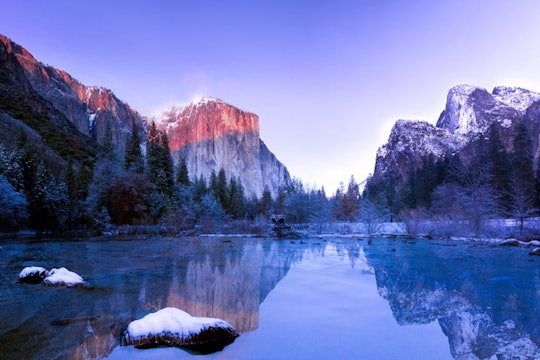What the Ice Age tells us about how plants will manage in a hotter world
New research seems to resolve a puzzle of why plants struggled in the past
When I started writing this article, I decided to prepare by (re)watching the first animated Ice Age movie.
You might remember the opening scene. The camera fades in to show a smooth horizon: it’s white and homogenous – a glacier as far as you can see – with big snowflakes spitting from the sky. Beyond a light wind, it's silent as a tiny figure materializes in the distance. It’s Scrat, the harried saber-tooth squirrel, ferreting for a spot to store his acorn in the hard-packed snow.
We must be somewhere in the middle latitudes, perhaps North America or Europe, where glaciers could have reached by the end of the last ice age 20,000 years ago, called the Last Glacial Maximum. As Scrat scurries about, we get glimpses of the surrounding land: ice sheets mostly, but with an occasional brown tuft of grass or several trees sticking up through thinner ice and snow. After stomping his acorn into a promising spot, the creature unwittingly cracks the icy surface below his feet and sends a shockwave that travels through a glacier precipice looming high above. It calves and begins sliding downhill toward him. As he runs for his life, we get more glimpses of the environment; it looks like a prehistoric Yosemite Valley, with small stands of sparse evergreen forest but few other plants on the brown and icy earth.
Admittedly, this may not have been the most productive 90 minutes of my life. But I wasn't watching for the plot or Scrat's comic relief, I was watching to get a sense of a different character: the land surface. From the opening scene, you can see that the land of Ice Age was much more extreme than it is now. Where large forests grow today, short, tough grasses grew then. And where grasses grow today, there was only tundra or desert in Scrat’s world. A natural question follows from these observations: why was there so much less vegetation? What was it about the land surface that made it difficult for plants to grow?
A sleeping giant
To answer those questions, it's important to start thinking about the land surface and the soil underneath as active characters in the climate system. In an average year, plants and soils absorb about 20 to 25 percent of the carbon dioxide emitted by human activity. A nearly equal amount is absorbed by the world’s oceans, and the remaining 55 percent stays in the atmosphere. This carbon “land sink” is incredibly important to the global carbon cycle, serving as a natural way to offset greenhouse gas emissions.
Understanding how this carbon sink works at the global scale, and working this information into climate models, is a crucial step toward predicting how concentrations of carbon dioxide will change in the future. If we can learn more precisely how much carbon dioxide the land surface can absorb, we can make better predictions for how much will be left over in the atmosphere and oceans. And this will give us a better idea of how much the Earth will warm – and how life, plant and human alike, will have to cope.
One of the most critical parts of this equation is figuring out how plants respond to different climate conditions, and why. In previous cold periods on Earth, there were more grasslands than forests, indicating that it was harder for plants to grow, especially the biggest ones, like trees. A simple explanation for this has long been that there was less precipitation over continents and soils were too dry to support plant growth. In a similar way, past warm climates have long been described as wet, due to the fact that warmer temperatures can evaporate more water into the atmosphere, and so in theory more precipitation can fall onto the continents.
Doubt on dry ice
But this simple explanation has recently been cast into doubt, because we know continents don’t simply become wetter as the climate warms or drier as it cools. Instead, atmospheric scientists have long predicted that under global warming, there will be alternating regions of more and less precipitation relative to today’s climate due to complex climate-induced changes in moisture and circulation. This reasoning would also be expected to work in the opposite sense: colder climates would also have alternating regions of wet and dry climate, calling into question the longstanding maxim that “glacials are dry.” This disagreement has been called the aridity paradox, and it has challenged some conclusions about how climate change influences plants (and vice versa), crucial members of the carbon-land sink equation.

Glacier Car Park, New Zealand
Enter Jack Scheff, a climate scientist and professor at the University of North Carolina, Charlotte. While he was a postdoc at Columbia University, he tried to disentangle these opposing stories. His tools: a huge catalog of vegetation observations from the Last Glacial Maximum (Scrat's epoch), and a set of state-of-the-art climate models.
In a Journal of Climate paper from November 2017, Scheff and colleagues aimed to answer two main questions. First, was it generally just “drier” during the Last Glacial Maximum in climate models, or were patterns more complex than that? And second, what do these models tell us about the aridity debate? Does the paradox stand the test of time? And more specifically: why were there fewer plants during the last ice age?
Paradox lost
To answer these questions, Scheff compiled a set of climate model simulations of the Last Glacial Maximum and then compared these to projections of future climate change. Just as we expect that future climate will have different regions of more and less precipitation—and wetter and drier land—these models show that the Last Glacial Maximum had these, too. In other words, they answered their first question: the patterns are complex; it wasn’t simply drier during the last ice age.
Critically, Scheff and his colleagues compared not just one measure for how “dry” or “wet” the climate was, but many. Some of these metrics emphasize soil dryness, while others give more weight to the atmosphere. They found that these measures produced widely different answers for how dry soils and near-surface air were during the last ice age. In some regions, one could conclude that it was both wetter and drier, depending on the measure used. This result isn’t a huge surprise, but it underscores the fact that climate scientists still debate how exactly we can best measure drought. While each approach has its merits, flaws, and particular uses, there is no one-size-fits-all option.

Torres del Paine National Park, Chile
Scheff's next step was to compare these different metrics of dryness to vegetation at the end of the last ice age, and to see which, if any, could explain the changes. The team found that in some places, where less vegetation grew, the model simulations predicted that soils were actually wetter, directly contradicting the idea that vegetation was scarce because the soil was dry.
Carbon starvation
This result helped solve the puzzle of what likely limited plant growth in Earth’s past: carbon dioxide. Since levels of carbon dioxide in the last ice age were half (or less) of today’s concentration, the authors conclude that this was likely the limiting factor, rather than drought. This idea isn’t completely new, but this study was the first occasion these ideas were confirmed during the Last Glacial Maximum using state-of-the-art climate models, spanning a range of drought metrics.
So why, in the end, was Scrat’s world so much browner than our own? There wasn’t enough carbon dioxide in the air to support vegetation. Instead of being water-starved, growth was limited because plants were carbon-starved. What's more, climate models tell us that even in regions where soils were wetter during the last ice age, there was less vegetation. The authors conclude that the aridity paradox isn’t really a paradox at all.
And what do these results mean for our predictions of future climate change and the carbon cycle? They suggest that the natural warming that that has occurred since the Last Glacial Maximum may serve as an analogue for what we predict will happen in the coming century, due to human-caused climate warming. With a more nuanced understanding of what limited plant growth in previous climates, we can better understand just how the world will warm in the near future, and how well our land surface will serve as a sink for carbon dioxide. After all, while predicting the future is hard business, the past has already happened – and we can measure that.



Cool article, and I know there's a lot of nuance that you couldn't fit in here! But I think that using the conclusion of these studies – that there weren't as many plants when it was cold because they were carbon-starved – to predict how plants will respond to warming only gets us so far.
From that, we could surmise that if plants aren't carbon starved and they have enough water, then the land carbon sink will continue to grow as the amount of carbon in the air increases. This happens to some extent (it's called the carbon fertilization effect), but we also know there's a limit to how much more plants can grow. I think that the bigger determination of future vegetation distributions is going to be water: we'll have more extreme rainfall and more extreme droughts, and the droughts will potentially severely limit the size of the carbon land sink.